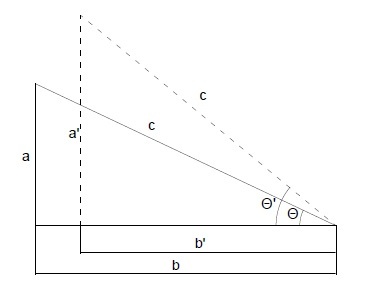Approximate Pythagoras
A pretty good approximation for the hypotenuse of a right triangle is to add half of the length of the shorter leg to that of the longer leg.

For what ratio of the legs is the approximation worst?
How poor is this approximation when expressed as ?
The first ratio can be written with coprime integers and the worst approximation can be written as with a squarefree integer and an integer.
Enter the total of
The answer is 10.
This section requires Javascript.
You are seeing this because something didn't load right. We suggest you, (a) try
refreshing the page, (b) enabling javascript if it is disabled on your browser and,
finally, (c)
loading the
non-javascript version of this page
. We're sorry about the hassle.

Let a = 1 then the approximation, which is always an overestimate, can be written as b + 0 . 5 ≈ 1 + b 2
We then need to maximize f ( b ) = 1 + b 2 b + 0 . 5
Which has derivative f ′ ( b ) = 1 + b 2 1 − ( 1 + b ) 3 / 2 b ( b + 0 . 5 )
Solving f ′ ( b ) = 0 gives b = 2 and f ( 2 ) = 2 5
So a = 1 , b = 2 , p = 5 , q = 2 and a + b + p + q = 1 0
If this problem is of interest to you, the harder follow-up is A better approximate Pythagoras